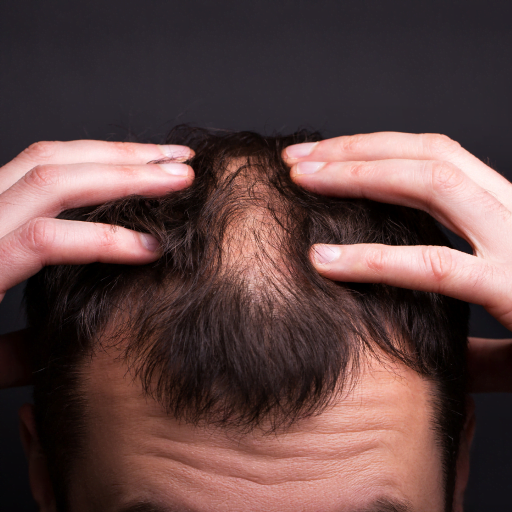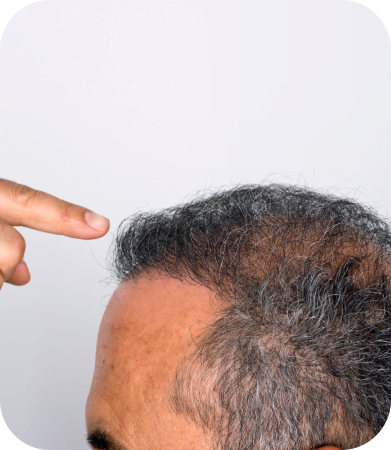An outpatient FUE transplant doesn’t require much post-operative time. You can go home shortly after the procedure finishes. The hair restoration doctor or clinician may ask you to wear bandages on your scalp for a few days. They may also prescribe antibiotics to prevent infection at the incision sites.
You might experience tenderness or swelling in the donor or recipient areas. But your hair transplant doctor or clinician can prescribe anti-inflammatories to reduce any discomfort. You should be able to return to work within a few days.
The transplanted hair will fall out within a few weeks of your procedure, but this process is normal. The individual hair follicles will remain and grow new hair within a few months.
FUE Hair Transplant Safety
FUE is a safe and proven hair transplant procedure. Complications are very rare. Like most minor surgeries, FUE does have a small risk of serious side effects.
Bleeding, scarring, hair loss, or infection can occur at the incision sites. Make sure to choose a qualified and experienced hair restoration specialist to minimize these risks.
FUE Hair Transplant Effectiveness
An FUE hair transplant is a tried-and-true hair loss treatment. Skilled providers can ensure that most of your transplanted hair follicular units thrive. One study showed that over 90% of the transferred hair follicles normally survive the FUE procedure and go on to grow new hair.
The FUE procedure doesn’t result in “the hair plugs look” from transplant procedures of the past. Most patients report they’re happy with the procedure and its long-term results. In one study and survey, FUE achieved a 98% satisfaction rate.
Moreover, an FUE transplant is a permanent correction. The transplanted follicles will remain for the rest of your life as they are genetically different. However, in some patients, the follicles may eventually produce less hair as overall hair loss progresses.
FUE Hair Transplant Pros and Cons
An FUE transplant has several advantages and disadvantages compared to other treatments such as follicular unit transplantation (FUT). During a FUT hair transplant procedure, your hair transplant surgeon removes a strip of your scalp to collect hair follicular units. The two procedures differ in terms of length, cost, and recovery time.
FUE Pros
- less pain
- no visible linear scars
- quick recovery
- works with short hairstyles
- can use more donor sites
Less Pain. An FUE hair transplant is less painful than a FUT. Removing a skin graft for an FUT can cause significant post-operative pain. The tiny incisions from an FUE cause less discomfort.
No Visible Linear Scars. An FUE transplant doesn’t scar your scalp as an FUT does. Since your hair transplant physician or clinician harvests individual hair follicular units, there’s no need to cut out a large skin graft. The small incisions heal within a few days with no noticeable scarring. Once your hair grows, the incisions are further hidden.
Quick Recovery. You can return to work more quickly after an FUE transplant than an FUT. The tiny, circular incisions heal very quickly without stitches. An FUT requires stitches and more time to heal the donor site.
Works With Short Hair Styles. You don’t need long hair to hide a scar after an FUE transplant. An FUT requires longer hair to cover the visible area left by the graft removal. The tiny incisions from an FUE leave no visible scarring so you can keep your hair very short without worrying.
Can Use More Donor Sites. An FUT generally takes a strip from the back of your head, while an FUE transplant is more flexible. It can use follicles from areas like your chest, back, or beard. This makes hair restoration available to some patients who lack the needed donor area for an FUT.
FUE Cons
- long procedure time
- Thinner donor area
- May not be as dense as an FUT.
Long Procedure Time. An FUE transplant takes longer than an FUT. Extracting individual follicular units instead of a large strip requires more work. The total time depends on the size of the treated area. You may need one long “mega” session of about eight hours, or you may have several shorter sessions throughout a couple of days.
Cost. An FUE hair transplant is comparable in price to an FUT hair transplant.
Larger Donor Area. An FUE transplant requires a larger area of healthy hair than an FUT. This is necessary to prevent noticeable thinning in the donor area.
Cutting Hair Short. Your provider has to cut your hair shorter before an FUE procedure than during an FUT. This allows them to better see which hair follicular units will make the best transplants. Many clinics offer a NO SHAVE FUE hair transplant.
FUE Hair Transplant New York City
Dr. Barnard and Clinician Daniels specialize in providing FUE in New York City. They offer FUE systems such as Cole, Ellis, and WAW to ensure you receive treatment tailored to your hair restoration needs.
FUE New York hair restoration is just one aspect of hair loss treatment. Every patient has unique needs when it comes to hair loss. That’s why Hair Transplant Specialists – New York City also offers scalp micro pigmentation, PRP hair restoration, PDO Threads, topical compounds, non-surgical treatments, vitamins, supplements, shampoos, and conditioners. Learn how we can help you achieve your best look.
FUE Hair Transplant Cost
The cost of an FUE hair transplant depends on the size of the area needing treatment which translates into a number of grafts as long as there is adequate donor hair available. Most insurance plans don’t cover FUE procedures.
Hair Transplant Specialists – New York City offers 0% financing and affordable prices to fit your budget. Contact us today to discuss pricing for follicular unit extraction and other treatment plans. The next step is a complimentary consultation at our Manhattan office located on Fifth Avenue.


